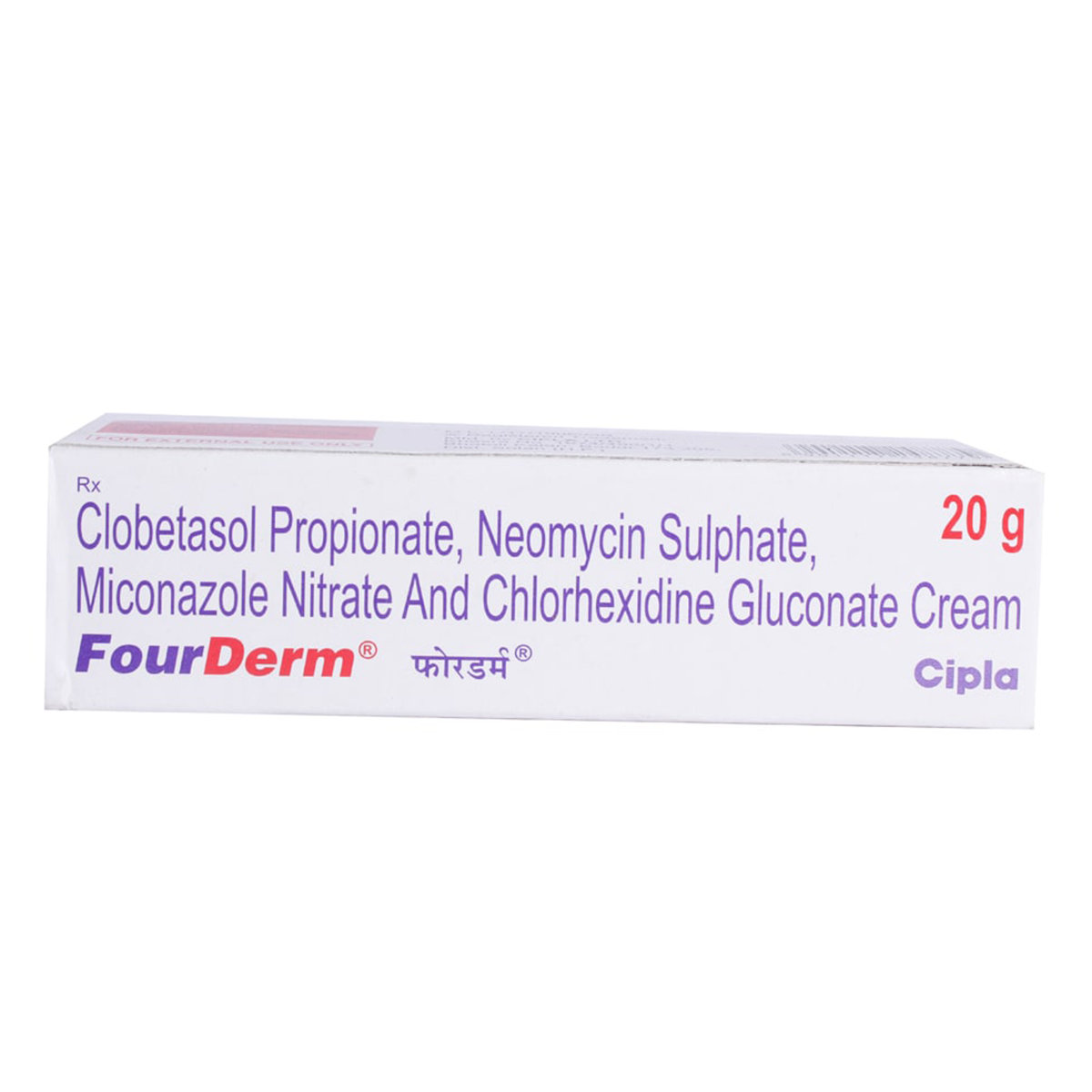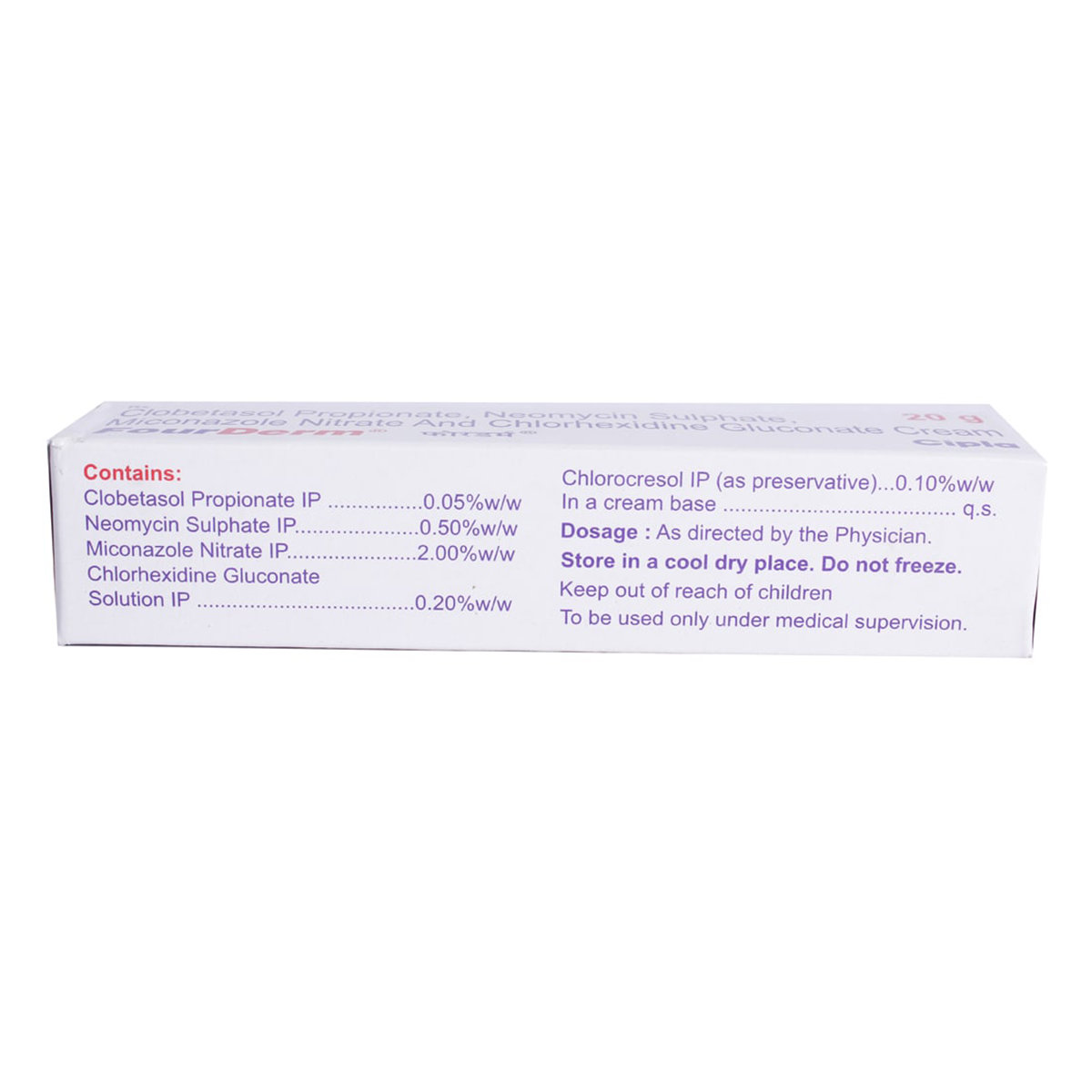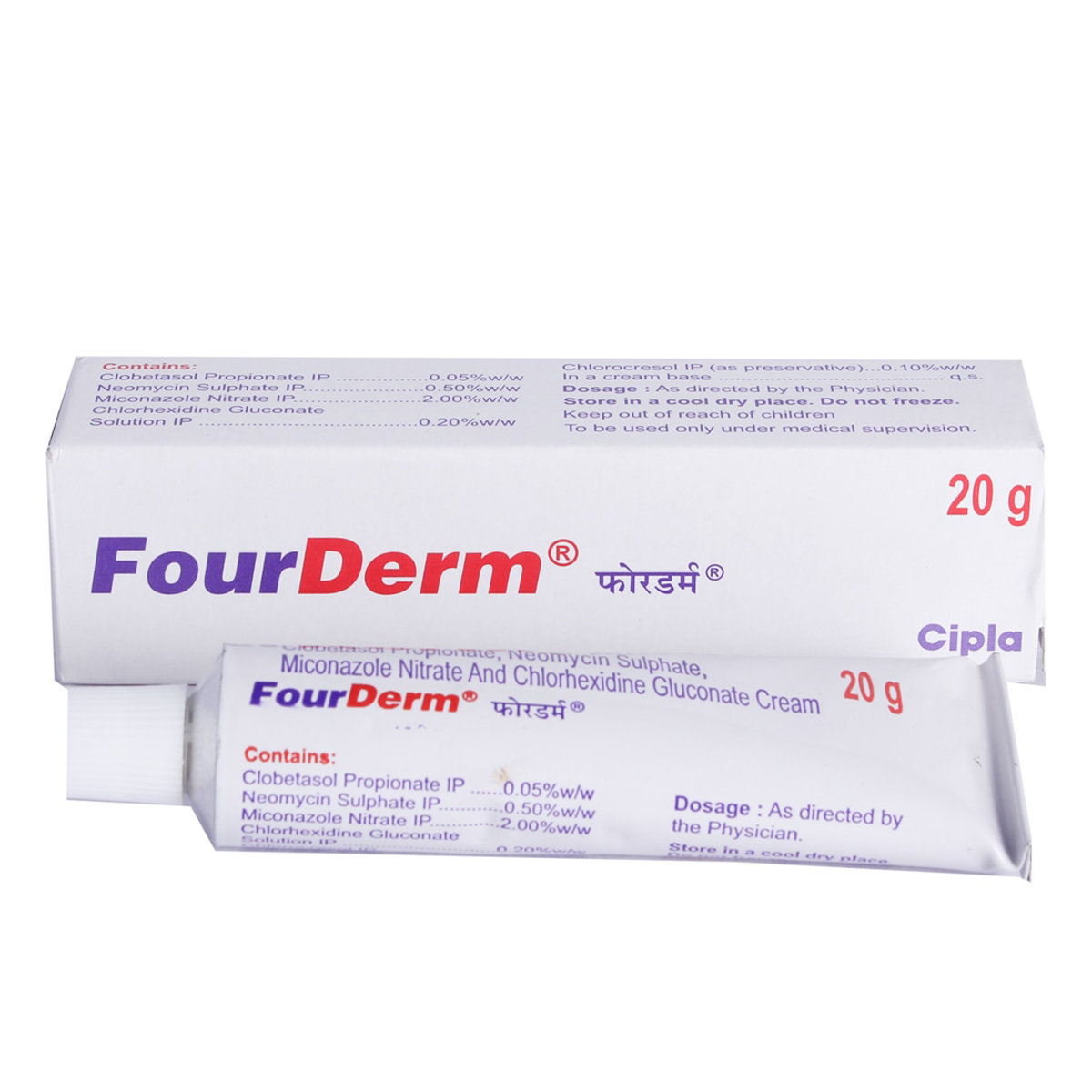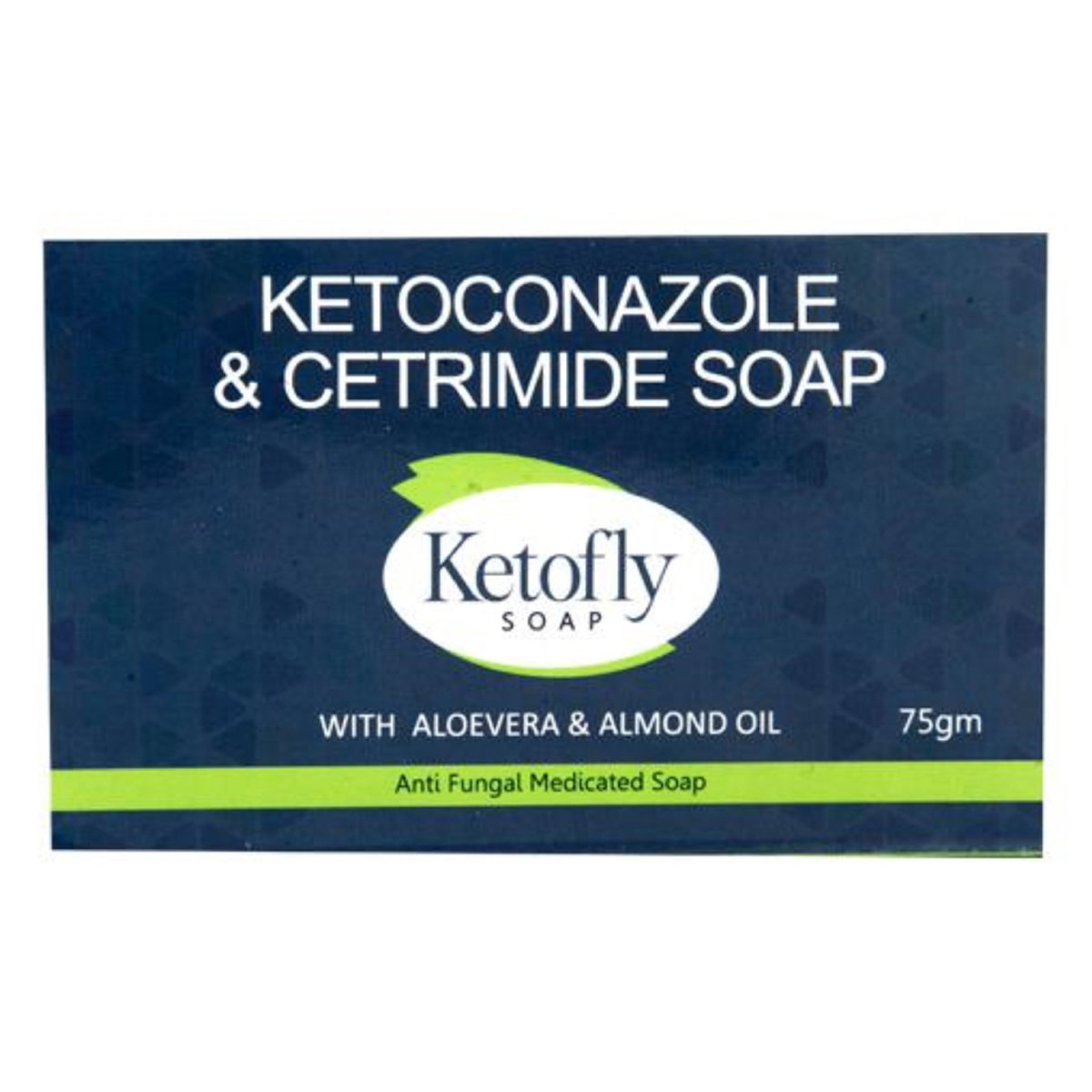Fourderm Cream 20 gm



Selected Pack Size:20 gm
20 gm ₹155.3
(₹7.77 / 1 gm)
In Stock
15 gm ₹124.2
(₹8.28 / 1 gm)
In Stock
10 gm ₹99.5
(₹9.95 / 1 gm)
In Stock
5 gm ₹57.6
(₹11.52 / 1 gm)
In Stock
MRP ₹172.5
(Inclusive of all Taxes)
₹25.9 Cashback (15%)
Know Your Delivery Time
Provide Delivery Location

Secure Payment

India's Most Trusted Pharmacy

Genuine Products
Manufacturer/Marketer :
Consume Type :
Return Policy :
Expires on or after :
About Fourderm Cream
Fourderm Cream is used to reduce swelling, itching, and redness caused by certain skin infections caused by bacteria and fungus. Fungal infection is a skin disease in which a fungus attacks the tissue and causes infection. Fungal infections may be contagious (spread from one person to another). Bacterial infection is a condition in which harmful bacteria grow in the body and cause infection. It can infect any part of the body and multiply very quickly.
Fourderm Cream is a combination of four drugs: Chlorhexidine (antiseptic), Clobetasol (corticosteroid), Miconazole (antifungal), and Neomycin (antibiotic). Chlorhexidine belongs to the class of antiseptics that works by killing the micro-organisms. It prevents infection. Clobetasol belongs to the class of corticosteroids that work by acting inside skin cells and inhibiting the release of certain chemical messengers in the body that cause redness, itching, and swelling. Miconazole belongs to the class of antifungals that works by causing holes in the fungal cell membranes and killing fungi. Neomycin belongs to the class of antibiotics that works by inhibiting the production of essential proteins that are necessary for bacteria to grow, multiply and increase in numbers. Thus, it kills the bacteria and fungi, preventing skin infection.
Fourderm Cream is only for external use. Use Fourderm Cream as prescribed. Avoid contact of Fourderm Cream with nose, ears, mouth, or eyes. In case Fourderm Cream comes in contact with these areas accidentally, rinse with water thoroughly. Some people may experience dry skin, skin rash, thinning of the skin, itching, swelling, redness, or burning sensation at the site of application. Most of these side effects of Fourderm Cream do not require medical attention and gradually resolve over time. However, if the side effects persist or worsen, please consult your doctor.
If you are known to be allergic to Fourderm Cream or any other medicines, please tell your doctor. If you are pregnant or a nursing mother, consult a doctor before using Fourderm Cream. Fourderm Cream should be used with caution in infants below 2 months old if prescribed by a doctor, as it may cause chemical burns or severe irritation in babies. Do not use Fourderm Cream in more than prescribed doses, or for a prolonged time as it may cause adverse effects. Avoid using Fourderm Cream on open skin wounds, deep cuts, or scrapes. Do not wrap or cover the treated area with bandages unless advised by your doctor. Do not swallow Fourderm Cream. In case of accidental swallowing, contact a nearby poison control centre or consult a doctor immediately. If you have adrenal gland or liver problems and any skin infection, inform your doctor before taking Fourderm Cream.
Uses of Fourderm Cream
Fourderm Cream used in the treatment of Skin infections. The detailed uses of Fourderm Cream are as follows:
- Treatment of Skin Infections: Fourderm Cream is effective in treating and preventing various skin infections, including fungal and bacterial infections.
- Reduces Inflammation: Fourderm Cream helps to reduce inflammation and swelling associated with skin infections and prevents secondary infections in inflamed skin.
- Relieves Symptoms: Fourderm Cream provides relief from symptoms like itching, redness, swelling, and discomfort associated with skin infections, promoting comfort during the healing process.
Health Queries
Ask Apollo
AI powered Health Chatbot
Ask Apollo
AI powered Health Chatbot
Ask Apollo
AI powered Health Chatbot
Ask Apollo
AI powered Health Chatbot

Have a query?
Directions for Use
- Fourderm Cream is for external use only.
- Follow your doctor's guidance regarding the dosage and timing of this medication for safe and effective use.
- Take a small amount of Fourderm Cream on the fingertip and apply it as a thin layer on the clean and dry affected area as advised by the doctor.
- Wash your hands before and after applying it unless the treatment is for your hands.
- If Fourderm Cream accidentally comes in contact with your eyes, mouth, or nose, rinse with water thoroughly.
Medicinal Benefits
Fourderm Cream is a combination of four drugs: Chlorhexidine, Clobetasol, Miconazole, and Neomycin. Chlorhexidine is an antiseptic that kills microorganisms and prevents infection. Clobetasol is a corticosteroid that works by acting inside skin cells and inhibits the release of certain chemical messengers in the body that cause redness, itching, and swelling. Miconazole is an antifungal that works by causing holes in the fungal cell membranes and kills fungi. Neomycin is an antibiotic that works by inhibiting the production of essential proteins that are necessary for bacteria to grow, multiply and increase in numbers. Thus, it kills the bacteria and fungi, preventing the spread of the skin infection.
How Fourderm Cream Works
Storage
What if I have taken an overdose of Fourderm Cream
Drug Warnings
If you are known to be allergic to Fourderm Cream or any other medicines, please tell your doctor. If you are pregnant or a nursing mother, it is advised to consult a doctor before using Fourderm Cream. Fourderm Cream should be used with caution in infants below 2 months old if prescribed by a doctor as it may cause chemical burns or severe irritation on babies. Do not use Fourderm Cream in more than prescribed doses, or for a prolonged time as it may cause adverse effects. Avoid using Fourderm Cream on open skin wounds, deep cuts, or scrapes. Do not wrap or cover the treated area with bandages unless advised by your doctor. Do not swallow Fourderm Cream. In case of accidental swallowing, contact a nearby poison control center or consult a doctor immediately. If you have adrenal gland or liver problems and any skin infection, inform your doctor before taking Fourderm Cream.
Drug-Drug Interactions
Drug-Drug Interactions
Login/Sign Up
Drug-Food Interactions
Drug-Food Interactions
Login/Sign Up
Diet & Lifestyle Advise
Regularly change your socks and wash your feet. Avoid shoes that make your feet sweaty and hot.
In wet places such as changing rooms and gym showers, don’t walk on barefoot. Wear flip-flops or sandals to prevent fungal infections.
Do not scratch the affected area of skin as it can spread the infection to other body parts.
Avoid sharing towels, combs, bedsheets, shoes or socks with others to prevent the spread of infection.
Wash your bed sheets and towels regularly.
Eat foods rich in quercetin (a flavonoid) such as apples, cherry, broccoli, spinach and blueberries.
Consuming food rich in probiotics helps in developing the immune system against allergies.
Limit intake of food that might trigger allergies such as dairy products, soy, eggs, and nuts.
Avoid consumption of foods with excess sugar as it may flare-up inflammation.
Include fruits, vegetables, whole grains, healthy fats and fish in your diet.
Avoiding getting in contact with harsh soaps, detergents and rough fabrics.
Habit Forming
Therapeutic Class
All Substitutes & Brand Comparisons
RX
Out of StockMegmazole GM Cream 20 gm
Megma Healthcare Pvt Ltd
₹72
(₹3.24/ 1gm)
58% CHEAPERRX
Out of StockDermasol-GM Cream 15 gm
Shinto Organics Pvt Ltd
₹69.9
(₹4.19/ 1gm)
46% CHEAPERRX
Neo Dermiford Cream 25 gm
Leeford Healthcare Ltd
₹120
(₹4.8/ 1gm)
38% CHEAPER
Alcohol
Caution
Interaction of Fourderm Cream with alcohol is unknown. Please consult a doctor before consuming alcohol while using Fourderm Cream.
Pregnancy
Caution
The safety of Fourderm Cream in pregnant women is unknown. Therefore, it is given to pregnant women only if the doctor thinks benefits outweigh risks.
Breast Feeding
Caution
It is unknown whether Fourderm Cream is excreted in human milk. Please consult a doctor before using Fourderm Cream while breastfeeding.
Driving
Safe if prescribed
Fourderm Cream usually does not affect your ability to drive or operate machinery.
Liver
Caution
If you have any concerns regarding the use of Fourderm Cream in patients with Liver problems, please consult a doctor.
Kidney
Caution
If you have any concerns regarding the use of Fourderm Cream in patients with Kidney problems, please consult a doctor.
Children
Caution
The safety of Fourderm Cream in children is unknown. Please consult a doctor.
Heart
Consult your doctor
Limited information available for use of Fourderm Cream in heart patients. Please consult your doctor.
Geriatrics
Consult your doctor
Limited information available for use of Fourderm Cream in elderly patients. Please consult your doctor.
FAQs
Fourderm Cream is used to treat bacterial and fungal skin infections. It helps reduce swelling, itching, and redness.
Fourderm Cream contains Chlorhexidine, Clobetasol, Miconazole and Neomycin. Chlorhexidine is an antiseptic that kills the micro-organisms and prevents infection. Clobetasol is a corticosteroid that works by acting inside skin cells and inhibits the release of certain chemical messengers in the body that cause redness, itching and swelling. When the skin reacts to any type of allergens, such chemicals are released normally. Miconazole is an antifungal that works by causing holes in the fungal cell membranes that are essential for their survival as they prevent the entry of unwanted substances into the cells and stops the leakage of cell contents. Thereby, kills fungi. Neomycin is an antibiotic that works by inhibiting the production of essential proteins that are necessary for bacteria to grow, multiply and increase in numbers. Thereby, kills the bacteria and clears the infection.
Yes, Fourderm Cream may cause staining of clothes. Therefore, avoid contact of Fourderm Cream with clothes or fabric and also avoid bleach to wash fabric that is in contact with Fourderm Cream as it may cause permanent stain.
No, you are not recommended to use Fourderm Cream on the face as the skin on the face is sensitive and thins easily. However, please consult a doctor before using Fourderm Cream on the face.
Fourderm Cream should be used with caution in children if prescribed by a doctor as Fourderm Cream contains a steroid and may increase the risk of Cushing’s syndrome, HPA axis suppression (suppression of inflammatory and immune responses), adrenal insufficiency, delayed growth and weight gain. However, please consult a doctor before using Fourderm Cream in children.
You are recommended to use Fourderm Cream for as long as your doctor has prescribed it. However, if the condition persists or worsens after 1 week of treatment with Fourderm Cream, please consult a doctor.
You are recommended to cover the treated area of skin with bandages or dressings only if advised by your doctor else it may increase the risk of side effects.
Yes, fungal infection is a contagious skin condition which spreads from one person to another through direct skin to skin contact or by contact with contaminated soil or surfaces and infected animals. Therefore, it is recommended to avoid close direct contact until the infection is clear and avoid sharing things with the infected person as it can also spread the infection.
No, you are not recommended to stop using Fourderm Cream without consulting your doctor as it may worsen the condition or cause recurring infection. Therefore, take Fourderm Cream for as long as your doctor has prescribed it, and if you experience any difficulty while taking Fourderm Cream, please consult your doctor.
Fourderm Cream may cause side effects such as skin rash, dry skin, thinning of skin and swelling, itching, redness or burning sensation at the application site. If these side effects persist or worsen, please consult your doctor.
Use Fourderm Cream as advised by the doctor. Take a small amount of Fourderm Cream on the finger and apply as a thin layer on the clean and dry affected area and surrounding skin. Avoid contact of Fourderm Cream with nose, mouth, or eyes. In case Fourderm Cream comes in contact with these areas accidentally, rinse with water thoroughly. Wash your hands before and after using Fourderm Cream if your hands are not the affected area to prevent the spread of infection.
Avoid using Fourderm Cream on face and contact with eyes. Do not apply a bandage or dressing on the treated area, as this will increase absorption of Fourderm Cream and increase the risk of side effects. Fourderm Cream should only be used for the condition it is prescribed for and should not be used for any other condition without consulting your doctor. Do not give it to others even if their condition appears to be similar.
Fourderm Cream should be used as per the dosage and duration advised by your doctor. Fourderm Cream contains Clobetasol which when used in higher doses and for prolonged duration can get absorbed in the blood circulation and cause Cushing's syndrome and adrenal suppression. It can cause high blood pressure, weight gain,, rounding of the face and increased hair growth. Also, it can cause a change in skin color at the application site. Veins beneath the skin become visible due to the weakening and thinning of the skin. If your symptoms worsen, please consult your doctor.
Store Fourderm Cream at room temperature. Do not freeze. Replace the cap tightly after use. Keep it out of reach of children.
Fourderm Cream is contraindicated in patients with known allergy to any its components or excipients. If you have any viral infections (herpes or chickenpox) or fungal infections (ringworm or athlete's foot), avoid using Fourderm Cream. It should not be used in the treatment of rosacea or acne. Consult your doctor before using Fourderm Cream for any condition.
Country of origin
Manufacturer/Marketer address
Customers Also Bought
Disclaimer
Author Details
We provide you with authentic, trustworthy and relevant information
Reference
- https://www.drugs.com/clobetasol-topical.html
- https://www.drugs.com/mtm/miconazole-topical.html
- https://www.drugs.com/cons/neomycin-topical.html#:~:text=Neomycin%20belongs%20to%20the%20family,are%20available%20without%20a%20prescription.
- https://www.drugs.com/drug-interactions/neomycin.html
- https://www.drugs.com/mtm/chlorhexidine-topical.html
Buy best Dermatology products by
Others
AYUR
MINTOP
Venusia
UV DOUX
KETO
ELOVERA
NEVLON
TUGAIN
FIXDERMA
ONABET
SELSUN
SOLSET
UVAVO
BETADINE
CANDID
MINOIL
KETAFUNG
MOISTUREX
REJUGLOW
TRICOMAX
TRUDERMA
ACTAME
BIOLINE
CLOCIP
Canesten
DERMADEW
KENZ
KETOMAC
MELALUMIN
OLESOFT
SLC
ZENSOFT
ZORAY
ECOKET
MELAGARD
MORR
NIXIPER
PHOTON
REJUHAIR
SUDERMA
SUNSTOP
AQUASOFT
CIPHANDS
CLINSOL
CUVIA
DEWDERM
DEWSOFT
DUCRAY
DYSIS
EKRAN
KETOL
LOZISOFT
MESODEW
MINOPEP
OILATUM
PARASOFT
PMT
SOLASAFE
SUNBAN
SUNCROS
ACCARE
ACMED
BLYNDS
COSALIC
DANCLEAR
DEPISHINE
Evion
GLAMBAK
GLYMED
HAIRGUARD
Hair Shield
ISDIN
KETOPZ
KTC
KZ
L-SKIN
LACNE
MEDERMA
MEDILICE
PERITOP
PERMED
PHOTOSTABLE
PHYSIOGEL
PSOROLIN
Q-SERA
RITCH
SOFIDEW
SUNMATE
TRIRISE
TVAKSH
ULTRA
UNISON
YUVINIE
A-DERMA
ACNE-UV
ACNESTAL
ACNESTAR
ACNETHRO
ADCROSS
Glenmark Pharmaceuticals Ltd
Canixa Life Sciences Pvt Ltd
Klm Laboratories Pvt Ltd
Sun Pharmaceutical Industries Ltd
Cipla Ltd
Intas Pharmaceuticals Ltd
Abbott India Ltd
Ajanta Pharma Ltd
East West Pharma India Pvt Ltd
Dr Reddy's Laboratories Ltd
Brinton Pharmaceuticals Ltd
Leeford Healthcare Ltd
Alkem Laboratories Ltd
Skinocean Pharmaceuticals
Amwill Healthcare Pvt Ltd
Atopic laboratories Pvt Ltd
Hegde & Hegde Pharmaceutica Llp
Torrent Pharmaceuticals Ltd
Palsons Derma Pvt Ltd
Dermacia Healthcare
Oaknet Healthcare Pvt Ltd
Ipca Laboratories Ltd
Micro Labs Ltd
Yaher Pharma
Med Manor Organics Pvt Ltd
Dermocare Laboratories Gujarat Llp
Apex Laboratories Pvt Ltd
Talent India Pvt Ltd
Kivi Labs Ltd
Mankind Pharma Pvt Ltd
Systopic Laboratories Pvt Ltd
Menarini India Pvt Ltd
Nemus Pharmaceuticals Pvt Ltd
Ethinext Pharma
Zydus Cadila
Regaliz Medicare Ltd
Inex Medicaments Pvt Ltd
Mohrish Pharmaceuticals Pvt Ltd
Hbc Dermiza Healthcare Pvt Ltd
Lupin Ltd
Mrhm Pharma Pvt Ltd
Zydus Healthcare Ltd
Eskon Pharma
GlaxoSmithKline Pharmaceuticals Ltd
La Pristine Bioceuticals Pvt Ltd
Praise Pharma
Wallace Pharmaceuticals Pvt Ltd
Newtrimed Healthcare Pvt Ltd
Biocute Life Care
Glowderma Lab Pvt Ltd
Macleods Pharmaceuticals Ltd
Sol Derma Pharmaceuticals Pvt Ltd
Aurel Biolife
Ethicare Remedies Pvt Ltd
Galcare Pharmaceuticals Pvt Ltd
Kaizen Drugs Pvt Ltd
Percos India Pvt Ltd
Rockmed Pharma Pvt Ltd
Elder Pharmaceuticals Ltd
Rely On Pharmaceuticals
Wockhardt Ltd
Zee Laboratories Ltd
Karlin Pharmaceuticals & Exports Pvt Ltd
Alniche Life Sciences Pvt Ltd
Connote Healthcare
La Med Healthcare Pvt Ltd
Prism Life Sciences Ltd
Yap Bioceuticals
P and P Dermaceuticals Pvt Ltd
Adonis Laboratories Pvt Ltd
Indiabulls Pharmaceuticals Pvt Ltd
Lyra Laboratories Pvt Ltd
Akumentis Healthcare Ltd
Albatross Healthcare Pvt Ltd
Apple Therapeutics Pvt Ltd
Arka Vital Science Pvt Ltd
Gary Pharmaceuticals Pvt Ltd
Rhine Biogenics Pvt Ltd
Yash Pharma Laboratories Pvt Ltd
Dermajoint India
Leogard Pharmaceuticals Pvt Ltd
Dermarex HealthCare India Pvt Ltd
Iceberg Health Care Pvt Ltd
Capital Pharma
Eumedica Pharamceuticals
FDC Ltd
Glasier Wellness Inc
Grace Derma Healthcare Pvt Ltd
Oziel Pharmaceuticals Pvt Ltd
Salve Pharmaceuticals Pvt Ltd
West Coast Pharmaceuticals Pvt Ltd
Entod Pharmaceuticals Ltd
Jenburkt Pharmaceuticals Ltd
Medcure Organics Pvt Ltd
Olcare Laboratories Pvt Ltd
Anhox Healthcare Pvt Ltd
Bioswizz Pharmaceuticals Ltd
Indchemie Health Specialities Pvt Ltd
Omniceutics Healthcare Pvt Ltd
Skinska Pharmaceutica Pvt Ltd
BODY CREAM
Body Lotion
Soap
Face Cream
Shampoo
Sun Screen
Face Gel
Face Wash
HAIR SOLUTION
BODY GEL
Face Serum
Hair Lotion
Hair Serum
Dusting Powder
ANTISEPTIC
Body Wash
Face Lotion
FACE CLEANSER
Body Spray
Foot Cream
Conditioner
Eye Cream
Eye Gel
Cleanser
Hair Cream
Hair Gel
Hair Spray
FUNGAL INFECTION
Hair Oil
Sanitizer
Specialty Supplements
Face Mask
Skin Ointment
Lip Balm
Capsule
Eye Serum
Intimate Wash
Hand Cream
Facial Spray
Face Toner
Hand Wash
SPECIALITY SUPPLEMENT
Tablet
BABY SUNSCREEN
Body Butter
Body Scrub
EYE SOLUTION
FACIAL WIPE
Gargle
Hair Color
Hair Mask
Hair Tonic
Intimate Spray
Lip Serum
VITAMIN D








